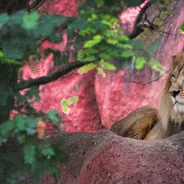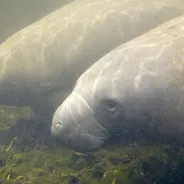With the majority of the ocean still unexplored, it's impossible to know for sure what sorts of creatures are out there lurking in the deep. Considering how terrifying a lot of the known inhabitants are, however, it's sometimes a little surprising that people are willing to venture out there at all.
Case in point: great white sharks.
With average great whites measuring between 3.4 and 4.9 meters (between two and three times the size of an average human male), they are formidable beasts, and have almost no natural predators. The largest great white to have ever been recorded was substantially bigger, though, coming in at almost seven meters (around 21ft) long - about the same size as a killer whale.
Nicknamed "Deep Blue", the record-breaking giant was first spotted in 1999, and then again in 2013. Just last week, she resurfaced once more in Hawaii - and the pictures of her are insane.
"Deep Blue, possibly the biggest White Shark identified, coming in at nearly 7 meters, was last spotted in Mexico," Mark Mohler, a photographer who captured some shots of the shark, wrote on Facebook. "She decided to come on a Hawaii all-you-can-eat vacation."
Other pictures from Mohler show a huge sperm whale carcass that Deep Blue was munching on at the time of the sighting. As she fed, she spread "chunks of whale and oil" in the water, the photographer said. Speaking to the divers who accompanied him on the shoot, Mohler added: "Thank you all for the surface support, surface photos and videos, and putting up with the smell."
Dr. Melanie Hutchinson, a shark expert at the University of Hawaii, was also among the group that spotted the legendary shark.
"About 20% of the population from California and Mexico migrate here every year or every other year," she explained. They normally gather in Hawaii during the winter, but carry out deep dives during the day - so they're not usually so easy to spot.
"I think the sperm whale kind of presented an opportunistic foraging opportunity so that's probably why people saw this animal," Dr. Hutchinson said.
The shark expert also warned that amateur divers should stay away from Deep Blue as, though great whites do not hunt in groups, it is possible that other species of shark could be attracted to the carcass, therefore making the surrounding waters highly dangerous.
Though it may seem obvious to avoid swimming near a seven-meter-long carnivore, divers have got pretty close before. In this previously-shot footage of Deep Blue, you can see how she dwarfs the people around her.
Hutchinson and the other divers were able to identify Deep Blue this time around as she had been tagged by previous researchers. By tagging sharks, scientists are able to broaden their understanding of the creatures: their lifespans, their feeding habits, and how they migrate at different times of the year. Right now, relatively little is still understood about them - so, who knows, there could easily be an even bigger shark out there waiting to be discovered... I just hope I'm not the one to encounter it.












